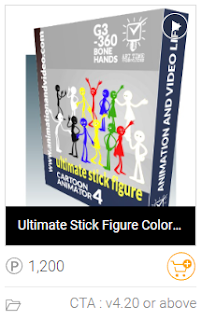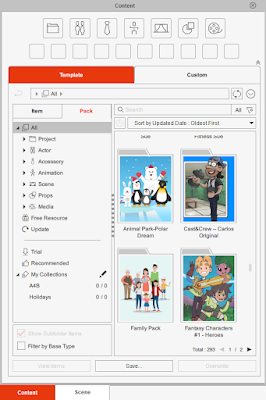Start Your 2D Animation Side Hustle - Sell Your Cartoon Animator Characters, Props, Scenes, and Motion Files in the Reallusion 2D/3D Marketplace
Have you thought about starting a side hustle selling your original Cartoon Animator assets in the Reallusion 2D/3D Marketplace? In this article, the first in a series on selling in the marketplace, I'll give you an overview of what's involved, why you should give it some thought, and whether you can earn enough to quit your day job (or at least have a worthwhile side hustle).
If you're an artist with any kind of drawing skills, and you're creating your own original characters, props, scenes, and even motion files for your Cartoon Animator projects, then setting up your own store in the Reallusion Marketplace should be a no brainer. You're making content already, it doesn't cost you anything to set up, and Reallusion only takes a 30% commission from each item sold. (If you think that's a lot, I'll address that further down).
Don't be put off if you think your art skills aren't up to professional standards. There are plenty of artists with naïve, outsider styles producing art and animation. In fact simple character design is current right now in many shows like Rick and Morty. In the video below, Brad Colbow, a YouTube technology reviewer for artists and illustrators, explains how he got his simplified drawing style... and he even went to art school!
The point being all art is subjective, and any style can be compelling - particularly once it's animated.
Getting Registered and Set Up
Setting up a store is much easier since the marketplace was redesigned, including a new backend management system. You no longer have to maintain a store front. Your author/store page looks just like a search results page filled with all your content. Allowing you to focus entirely on making your product pages look great with plenty of preview images and detailed description.
Previously you had to download a separate application to upload content to the marketplace. Cartoon Animator 5 introduced the Smart Content Manager and Package Manager, allowing you to upload, and update your content right inside the software. There are still some elements to manage in your store's backend (accessed from your Reallusion account when you're in the Marketplace).
To register as a Content Developer. These are the steps to join along with all the information you need to set up your store.
DA Points
Everything in the marketplace is bought and sold with Reallusion's own digital currency, Direct Access (DA) points. One US Dollar equals one hundred DA Points. The system makes it easier to process thousands of micro payments instantly without having to deal with credit card fees, payment gateways, bank transfers etc. on every sale.
DA Points can be bought, earned by leaving reviews on content you have purchased, or selling your own content.
To cash out your DA points from sales you'll need to apply to become a Certified Content Developer (you'll find the details for this on the sales page in your account). Once you make sales of USD$100.00 or more, and are approved as a CCD, your funds will automatically cash out to your PayPal account on the same specified date each month. Wire transfers to a bank account are also available but the payment threshold is USD$1000.00.
Q: Why Sell in the Marketplace? A: To Fund Your Marketplace Purchases
October of 2017, I set up my own store which, at the time of writing, only has thirteen content packs listed. While that doesn't seem like much, the DA points I've earned have funded a lot of the purchases I've made from other marketplace sellers.
 |
| Even with a small number of packs in my own store, I've earned more than enough to fund a lot of my own marketplace purchases. |
That's Nice But Can I Make REAL Money and Quit My Job?
 |
| Garry Pye created this Money Prop Pack not long after opening his store. I think it may have been aspirational. |
That said, it is important you understand the business model. Selling in the Marketplace is what's known as a 'high volume' business. Which is a business that sells large amounts of low cost items to make a profit.
In simple terms, if you want to make USD$5000 per month, that means you need to sell 250 items priced at $20.00 every month i.e. high volume.
Sales in the Reallusion Market place are subject to a 70%-30% profit split. i.e. you get 70% of the sale while Reallusion retains 30%. Therefore, with my simplified figures above, you'd need to make even more sales to make up the 30% short fall to clear $5000 per month.
Making a full time, living income is not out of the question. However, running a store at that level is not a simple case of uploading random content you've made for your projects and waiting for sales.
You will get some sales from people browsing the marketplace, however you will need to learn how to research what is in high demand in the way of content, how to spot underserved niches, and how to promote your content to potential buyers so they keep coming back for your new releases.
 |
| My Ultimate Stick Figure pack is my best seller through search alone. |
30% Commission to Reallusion Seems a Lot. Can't I Just Make My Own Website Store?
You could... and keep 100% of the profit (after web hosting fees, shopping cart fees, payment processing fees etc.), however, if you're a registered Content Developer for Reallusion, it states right in the Developer Agreement that you can't sell your content through anywhere other than Reallusion's Stores.
Reallusion currently doesn't enforce that part of the Developer Agreement. There are several high profile developers with their own stores. Potentially, you could be running the risk of having your marketplace store and Reallusion account terminated should they become more strict on the rules. Which is a documented consequence if you're repeatedly caught plagiarizing and selling content that's not your own in the marketplace.
Additionally, selling outside the Marketplace, means your content is not protected by Reallusion's built in Digital Rights Management system. Anyone can share your content they've purchased with anyone without any further payment to you.
 |
| Packs purchased in the Market are easily installed, as needed, from the User's Reallusion account through CTA's Smart Content Manager. |
Personally, I no longer buy from seller's external website stores for this reason. Controversial opinion: the seller is asking you to give up some of the convenience of the Smart Content Manager so they can keep more of their profit. That's a win/lose situation in favor of the seller to me.
The biggest benefit of selling in the marketplace is, that's the first place people look when they require content. They don't search Google first. You'll make quite a number of sales just by making your listing search friendly (including relative keywords in the title and description). As mentioned previously most of my sales come from my stick figures because that's something people are searching for.
Selling only on your own website (without being a registered developer) you'll have to do all the marketing yourself just to get people browsing your site. Not impossible but a very real challenge to meet.
Wait... Don't You Have Your Own Store?
 |
| Learn how to animate text using CTA's Text Tools. |
There is no way you can sell a video tutorial course, or even a PDF tutorial document, through the marketplace at this time.
I would absolutely love it if I could, because people browsing the marketplace for Cartoon Animator content, are the exact people most likely to buy Cartoon Animator tutorials. This is why I have free characters in my store that promote my tutorials.
Want to Know More About Selling in the Marketplace?
As mentioned up top, this is the first in a series of articles about the Reallusion Marketplace. While the focus is on 2D content much of the information applies to selling 3D content. I've studied the marketplace quite a bit, particularly keeping an eye on successful sellers and what they do.
Things I plan to cover include (these are not necessarily separate posts):
- How to know what to sell, and finding niches.
- Things to consider when designing content. (one off items versus a series).
- An overview of how to upload, price, and package your content.
- How to promote your content outside the marketplace.
I realize my own track record in the marketplace gives me next to no credibility on how to run a successful store however, I have built a successful Cartoon Animator Course and Tutorial business, in a market that is very biased toward free tutorials, in the face of Reallusion, who release excellent free tutorials for all their software.
You're also reading from a successful blog/newsletter business I run, and my @AnimLife Youtube channel is gaining momentum with over 209 new subscribers in the last 90 days (as of writing this) and all my stats have been on the rise since September 2023 when I decided to really focus on making at least two videos per month.
Hopefully that all tells you that, to be successful at anything, you have to give it some attention, and do the work.
o---o--- ---o--- o---
Did you find this article useful?
Subscribe to my newsletter and get the
latest articles delivered to your inbox.
Did you find this article useful?
Subscribe to my newsletter and get the
latest articles delivered to your inbox.



Comments
Post a Comment
This blog is monitored by a real human. Generic or unrelated spam comments with links to sites of dubious relativity may be DELETED.
I welcome, read, and respond to genuine comments relating to each post. If your comment isn't that save me some time by not posting it.